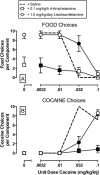Preclinical Assessment of Lisdexamfetamine as an Agonist Medication Candidate for Cocaine Addiction: Effects in Rhesus Monkeys Trained to Discriminate Cocaine or to Self-Administer Cocaine in a Cocaine Versus Food Choice Procedure
- PMID: 25618405
- PMCID: PMC4458439
- DOI: 10.1093/ijnp/pyv009
Preclinical Assessment of Lisdexamfetamine as an Agonist Medication Candidate for Cocaine Addiction: Effects in Rhesus Monkeys Trained to Discriminate Cocaine or to Self-Administer Cocaine in a Cocaine Versus Food Choice Procedure
Abstract
Background: Chronic amphetamine treatment decreases cocaine consumption in preclinical and human laboratory studies and in clinical trials. Lisdexamfetamine is an amphetamine prodrug in which L-lysine is conjugated to the terminal nitrogen of d-amphetamine. Prodrugs may be advantageous relative to their active metabolites due to slower onsets and longer durations of action; however, lisdexamfetamine treatment's efficacy in decreasing cocaine consumption is unknown.
Methods: This study compared lisdexamfetamine and d-amphetamine effects in rhesus monkeys using two behavioral procedures: (1) a cocaine discrimination procedure (training dose = 0.32mg/kg cocaine, i.m.); and (2) a cocaine-versus-food choice self-administration procedure.
Results: In the cocaine-discrimination procedure, lisdexamfetamine (0.32-3.2mg/kg, i.m.) substituted for cocaine with lower potency, slower onset, and longer duration of action than d-amphetamine (0.032-0.32mg/kg, i.m.). Consistent with the function of lisdexamfetamine as an inactive prodrug for amphetamine, the time course of lisdexamfetamine effects was related to d-amphetamine plasma levels by a counter-clockwise hysteresis loop. In the choice procedure, cocaine (0-0.1mg/kg/injection, i.v.) and food (1g banana-flavored pellets) were concurrently available, and cocaine maintained a dose-dependent increase in cocaine choice under baseline conditions. Treatment for 7 consecutive days with lisdexamfetamine (0.32-3.2mg/kg/day, i.m.) or d-amphetamine (0.032-0.1mg/kg/h, i.v.) produced similar dose-dependent rightward shifts in cocaine dose-effect curves and decreases in preference for 0.032mg/kg/injection cocaine.
Conclusions: Lisdexamfetamine has a slower onset and longer duration of action than amphetamine but retains amphetamine's efficacy to reduce the choice of cocaine in rhesus monkeys. These results support further consideration of lisdexamfetamine as an agonist-based medication candidate for cocaine addiction.
Keywords: Lisdexamfetamine effects in rhesus monkeys; addiction; choice; cocaine; lisdexamfetamine; rhesus monkey.
© The Author 2015. Published by Oxford University Press on behalf of CINP.
Figures




References
-
- Ahmed SH, Lenoir M, Guillem K. (2013) Neurobiology of addiction versus drug use driven by lack of choice. Curr Opin Neurobiol 23:581–587. - PubMed
Publication types
MeSH terms
Substances
Grants and funding
LinkOut - more resources
Full Text Sources
Other Literature Sources
Medical

